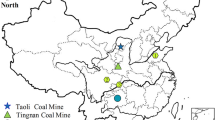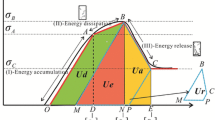Abstract
The brittleness index (BI), which serves as a key reference for reservoir fracturing, is also an important quantitative index for the evaluation of coal-bed methane (CBM) reservoirs. To address the lack of research regarding this application of the BI, we measured the ultrasonic wave velocity of 10 coal samples collected from the Qinshui Basin, China. We then calculated the BI in three test directions, i.e., BI(90°), BI(45°), and BI(0°), as well as the BI anisotropy value (ABI) using the dynamic elastic method. Analysis of the calculated results showed that BI(90°) generally had the highest values and that BI(45°) was close to BI(0°). The ABI showed a positive correlation with the dynamic Young’s modulus anisotropy value, dynamic Poisson’s ratio anisotropy value, S-wave velocity anisotropy value, and the ratio of P-wave and S-wave velocity anisotropy values. However, the ABI had an unclear correlation with the P-wave velocity anisotropy value. Further analysis of the correlation between the BI and two other reservoir parameters (coal structure type and fracture development) revealed that samples with high BI values generally corresponded to primary or fragmented types of coal and also had low Poisson’s ratios, which indicates undeveloped fractures, while samples with low BI values corresponded to granulated types of coal and had high Poisson’s ratios, which indicates developed fractures. We investigated these correlations in order to understand the multiparameter constraints and their combined application in brittleness evaluations, which could reduce risk and improve the precision of ideal brittleness identification in CBM reservoirs.










Similar content being viewed by others
References
Altindag R (2003) Correlation of specific energy with rock brittleness concepts on rock cutting. J S Afr Inst Min Metall 103(3):163–171
Chen J, Xiao X (2013) Mineral composition and brittleness of three sets of Paleozoic organic-rich shales in China South area. J China Coal Soc 38(5):822–826
Copur H, Bilgin N, Tuncdemir H, Balci C (2003) A set of indices based on indentation tests for assessment of rock cutting performance and rock properties. J S Afr Inst Min Metall 103(9):589–599
Diao H (2013) Rock mechanical properties and brittleness evaluation of shale reservoir. Acta Petrol Sin 29(9):3300–3306
Dong S, Tao W (2008) Test on elastic anisotropic coefficients of gas coal. Chin J Geophys 51(3):671–677
Dong S, Wu H, Li D, Huang Y (2016) Experimental study of ultrasonic velocity and anisotropy in coal samples. J Seism Explor 25(2):131–146
Fu X, Qin Y, Wei Z (2007) Coal-bed methane geology. China University of Mining and Technology Press, Beijing
Guo Z, Li X, Liu C, Feng X, Ye S (2013) A shale rock physics model for analysis of brittleness index, mineralogy and porosity in the Barnett Shale. J Geophys Eng 10(2):1–10
Honda H, Sanada Y (1956) Hardness of coal. Fuel 35:451
Huang X, Huang J, Li Z, Yang Q, Sun Q, Cui W (2015) Brittleness index and seismic rock physics model for anisotropic tight-oil sandstone reservoirs. Appl Geophys 12(1):11–22
Hucka V, Das B (1974) Brittleness determination of rocks by different methods. Int J Rock Mech Min Sci Geomech Abstr 11(10):389–392
Liu B, Xi D, Ge N, Wang B, Kern H, Popp T (2002) Anisotropy of Poisson’s ratio in Rock Samples at Different Confining Pressures. Chin J Geophys 45(6):880–890
Morcote A, Mavko G, Prasad M (2010) Dynamic elastic properties of coal. Geophysics 75(6):E227–E234
Peng S, Gao Y, Yang R, Chen H, Chen X (2005) Theory of application of AVO for detection of coalbed methane - A case from the Huainan coalfield. Chin J Geophys 48(6):1475–1486
Peng S, Chen H, Yang R, Gao Y, Chen X (2006) Factors facilitating or limiting the use of AVO for coal-bed methane. Geophysics 71(4):C49–C56
Qian K, He Z, Chen Y, Liu X, Li X (2017) Prediction of brittleness based on anisotropic rock physics model for kerogen-rich shale. Appl Geophys 14(4):463–480
Quinn J, Quinn G (1997) Indentation brittleness of ceramics: a fresh approach. J Mater Sci 32(16):4331–4346
Ramos A (1997) 3-D AVO analysis and modeling applied to fracture detection in coalbed methane reservoirs. Geophysics 62(6):1683–1695
Rickman R, Mullen M, Petre J, Grieser B, Kundert D (2008) A practical use of shale petrophysics for stimulation design optimization: all shale plays are not clones of the barnett shale. SPE Technical Conference and Exhibition. Society of Petroleum Engineers: 115258
Ulusay R (2015) The ISRM suggested methods for rock characterization, testing and monitoring: 2007–2014. Springer, Berlin
Wang Y, Xu X (2012) Characteristics of P-wave and S-wave velocities and their relationships with density of six metamorphic kinds of coals. Chin J Geophys 55(11):3754–3761
Wu H, Dong S, Li D, Huang P, Qi X (2015) Experimental study on dynamic elastic parameters of coal samples. Int J Min Sci Technol 25(3):447–452
Yu G, Vozoff K, Durney D (1991) Effects of confining pressure and water saturation on ultrasonic compressional wave velocities in coals. Int J Rock Mech Min Sci Geomech Abstr 28(6):515–522
Yu G, Vozoff K, Durney D (1993) The influence of confining pressure and water saturation on dynamic elastic properties of some Permian coals. Geophysics 58(1):30–38
Yuan J, Deng J, Zhang D, Li D, Yan W, Chen C, Cheng L, Chen Z (2013) Fracability evaluation of shale-gas reservoirs. Acta Petrol Sin 34(3):523–527
Zhou F (2012) Experiment of influence of fractures on coal/rock acoustic velocities: with carboniferous seams of Qinshui basin as example. Coal Geol Explor 40(2):71–74
Acknowledgements
We would like to thank the Anhui Key Research and Development Program (Grant No. 1804a0802203), the Natural Science Foundation of the Anhui Higher Education Institutions (Grant Nos. KJ2018A0071, KJ2016A192), and the Natural Science Foundation for Young Teachers in AUST (Grant No. QN2017202) for supporting this study. We also thank Li Donghui and Xue Haifei for their help with the coal sample testing. Finally, many thanks are due to the anonymous reviewers and the editor for their valuable suggestions.
Author information
Authors and Affiliations
Corresponding author
Ethics declarations
Conflict of interest
On behalf of all authors, the corresponding author states that there is no conflict of interest to declare.
Rights and permissions
About this article
Cite this article
Wu, H., Zhang, P., Dong, S. et al. Brittleness index analysis of coal samples. Acta Geophys. 67, 789–797 (2019). https://doi.org/10.1007/s11600-019-00291-5
Received:
Accepted:
Published:
Issue Date:
DOI: https://doi.org/10.1007/s11600-019-00291-5




